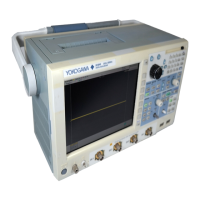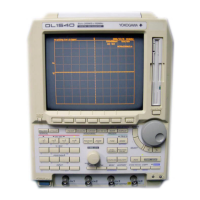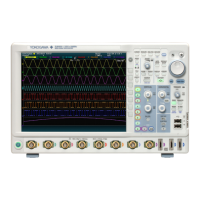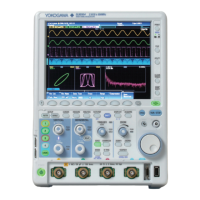2-18 IM 701450-01E
Display Format <For the setup procedure, see section 8.1>
Splitting the Screen
The screen can be split evenly so that input waveforms and computed waveforms can be
easily viewed. The screen can be divided into the following:
Single (no division), Dual (two divisions), Triad (three divisions), Quad (four divisions),
Hexa (six divisions), and Octal (eight divisions, DL7480 only)
Waveform Mapping
You can select the mapping of the input channels to the divided windows.
Auto
Waveforms whose display is turned ON are assigned in order from the top.
Fixed
Waveforms are assigned in order from the top regardless of whether the display is turned ON
or OFF.
User
The waveforms can be assigned arbitrarily to the divided windows regardless of whether the
display is turned ON or OFF.
Displaying Waveforms and Logic Signals
When displaying logic signals on the screen, the normal waveforms and logic signals can
be displayed simultaneously on divided windows or only the logic signals can be
displayed over the entire screen.
Display Interpolation <For the setup procedure, see section 8.2>
In
interpolation areas
where less than 500 points of data exists in 10 divisions along the
time axis (or less than 250 points in the zoom display section when waveforms are
zoomed in Main&Z1&Z2), a continuous waveform cannot be displayed because there
are not enough sampled points. In this case, the waveform is displayed by interpolating
between data points. You can select the interpolation method.
Sine Interpolation
Generates interpolation data using the function
sin x
x
then interpolates between two dots
using the resulting sine curve. Sine interpolation is suitable for observing sine waves or
similar waves.
Linear Interpolation
Linearly interpolates between two points.
Pulse Interpolation
Interpolates between two points in a step pattern.
Interpolation OFF
Displays discrete dots without performing interpolation.
Sine interpolation Pulse interpolation Interpolation OFF
Linear interpolation
Accumulated Display <For the setup procedure, see section 8.3>
The display time of old waveforms can be set longer than the waveform update period,
so that newer waveforms appear overlapped (accumulated) on older waveforms. The
following two modes are available. Accumulated display is useful when observing jitters
and temporary turbulence in waveforms.
Persist Accumulates waveforms using a single color for each channel.
Color Accumulates waveforms using eight colors indicating data frequency information.
2.4 Waveform Acquisition and Display Conditions
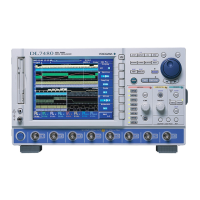
